David Bradshaw Photos Vol. LXXIX, K-22 Part 1
Jul 15, 2015 21:29:58 GMT -5
brionic, Doc Barranti, and 3 more like this
Post by Lee Martin on Jul 15, 2015 21:29:58 GMT -5
Smith & Wesson purchased used in the early 1960's from fellow college student, this K-22 pitched many a rabbit and grouse into the feed bag. Numerous pocket pool bullseye shooters bandied one or more Colt Officer's Model Match in their pistol box, like they'd never part with the wheelgun, all the while shooting the High Standard auto, which had kicked the Colt and S&W revolvers----along with the Colt Woodsman Match Target----off the rimfire firing line. David paid $50 for this K-22, with an extra fivespot for a Bill Jordan holster made by the great S.D. Myers of El Paso. (Half a century later the holster is perfect.)
Photo indicates two cylinders worth of .22 Long Rifles stroked in 2006, double action at 100 yards.

K-22 cartridge roll mark.on the old drop forged 6-inch barrel.
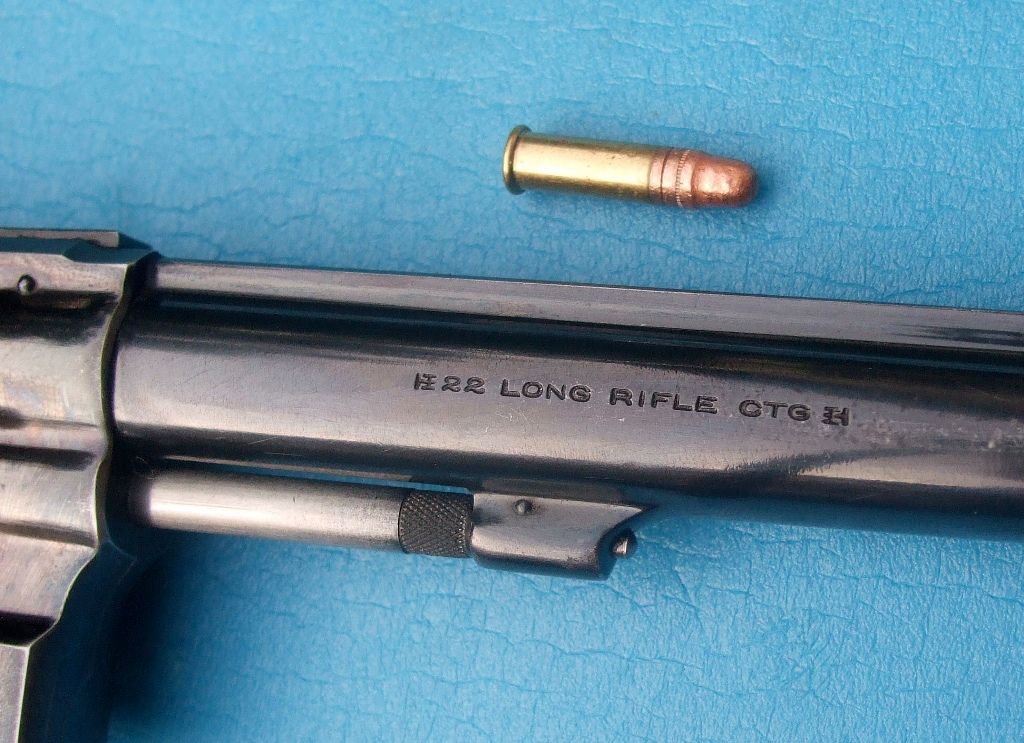
Vintage K-22. Flat black paint applied on occasion to protect against weather and preserve bluing. Paint shows around grip and trigger, etc.

Perhaps no revolver is more sensitive to dimensional irregularity than a .22 rimfire. The chamber has no step. Rather, the chamber narrows ever so slightly rear-to-front. Long Rifle ammo snugs into the exit hole. A soft lead bullet cannot abide caveman manufacturing, the K-22 representing the extreme opposite.

Close shave as lubed lead bullet enters chamber from the front.

Upon swingout, index and middle fingers of left hand hold cylinder at 9 o'clock to frame for clear ejection----and to prevent extractor star from scratching revolver! Normal ejection calls for muzzle to be raised to prevent brass and crap from collecting under star.
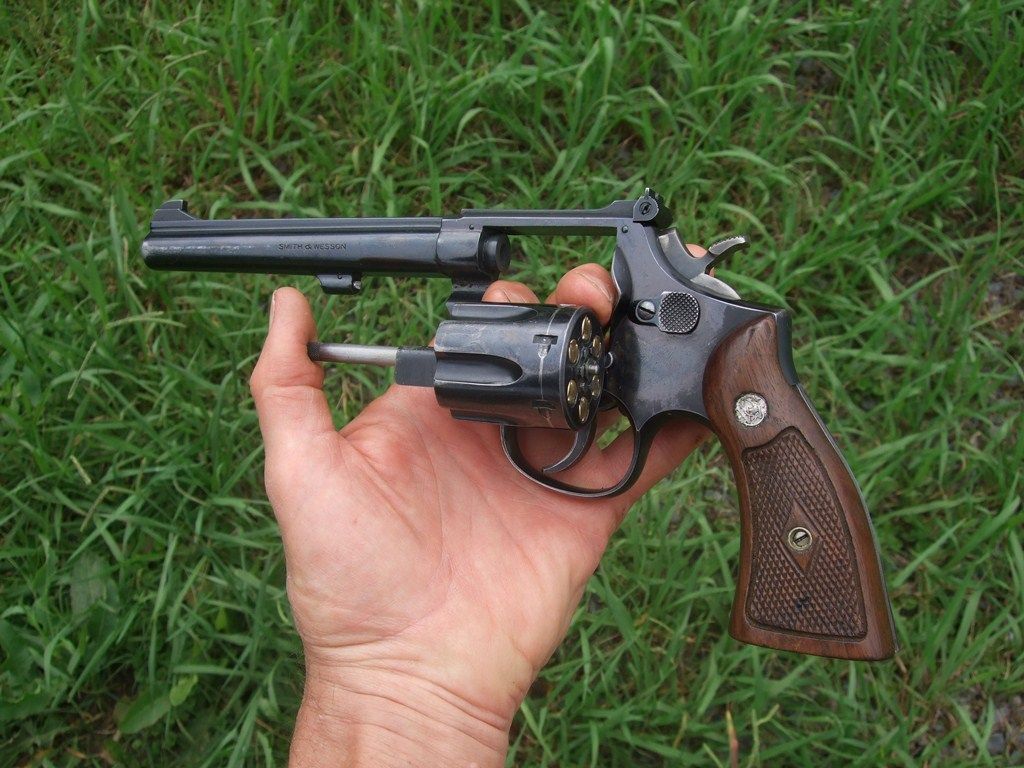
Most elegant Patridge sight to ever put on a handgun.
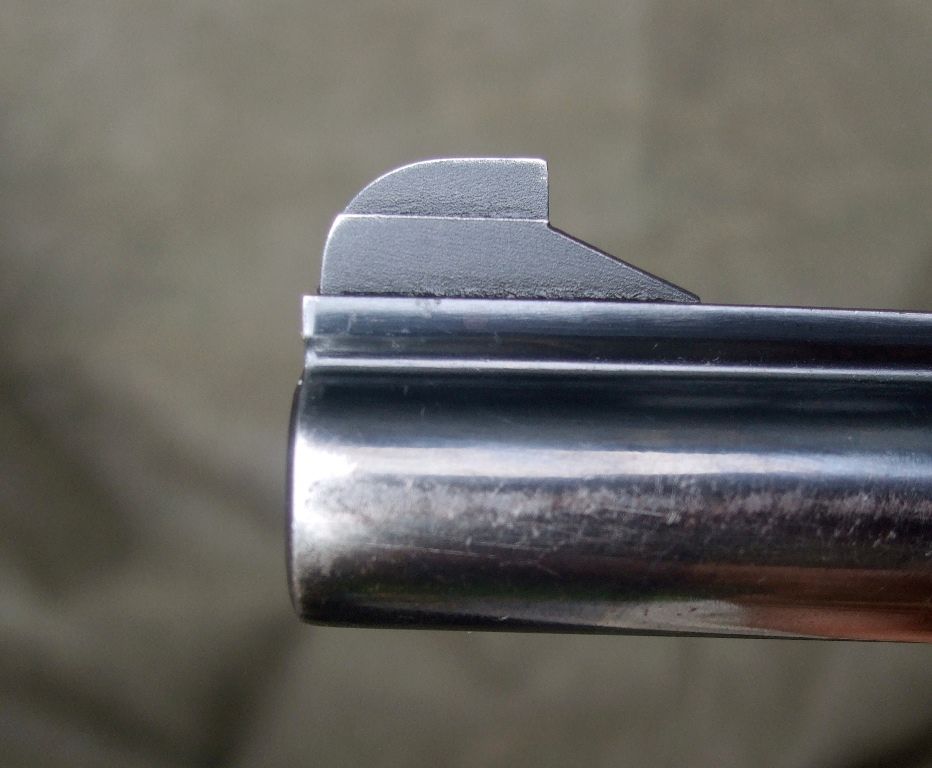
As the smoke of World War II drifted off, Smith & Wesson stepped once again into the sporting market, a most welcome development the fine rear sight with micro-clicks for elevation and windage. A detent ball in the flange of the respective screws makes for consistent adjustments. Among the many drop forged parts, the rear sight base. A habitual lubricator, with only Lubriplate white lithium grease at hand, David got carried away.
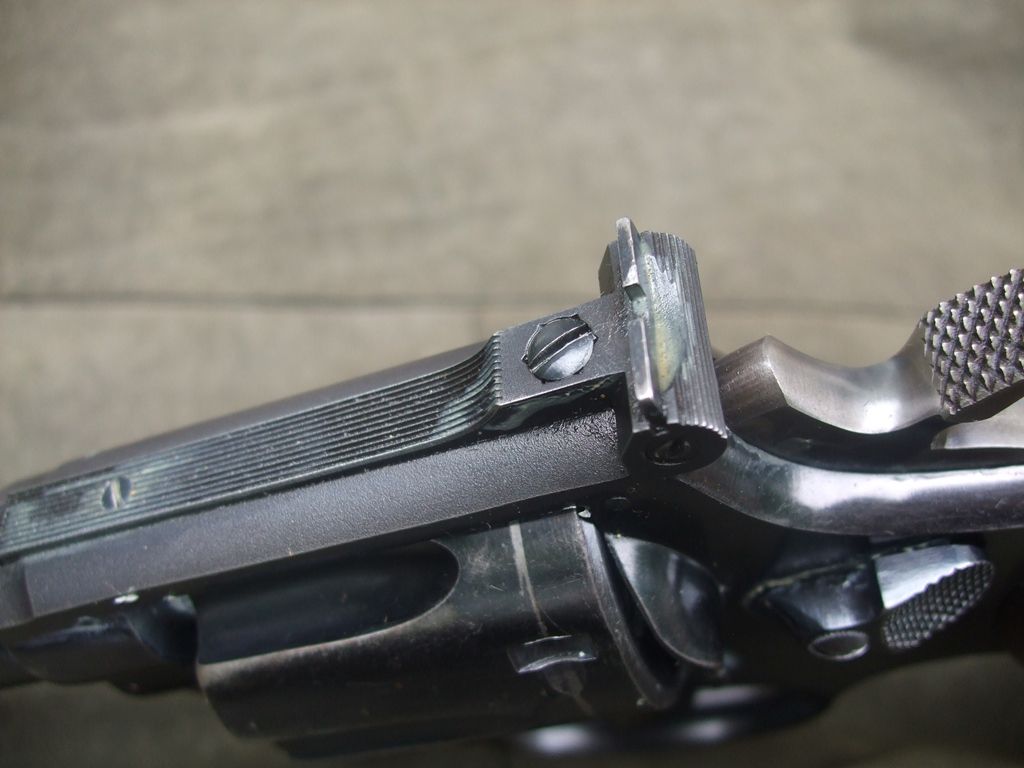
Note, immediately behind painted trigger, a little nubbin. This is the trigger stop, secured by a screw. Access requires removal of sideplate. Should the trigger stop screw loosen, adjustment nubbin may drop down, which then prevents trigger from releasing hammer. No such adversity has struck this K-22. S&W saw the potential and chose a rod inside the trigger rebound spring to limit overtravel in the .44 Magnum Model 29.
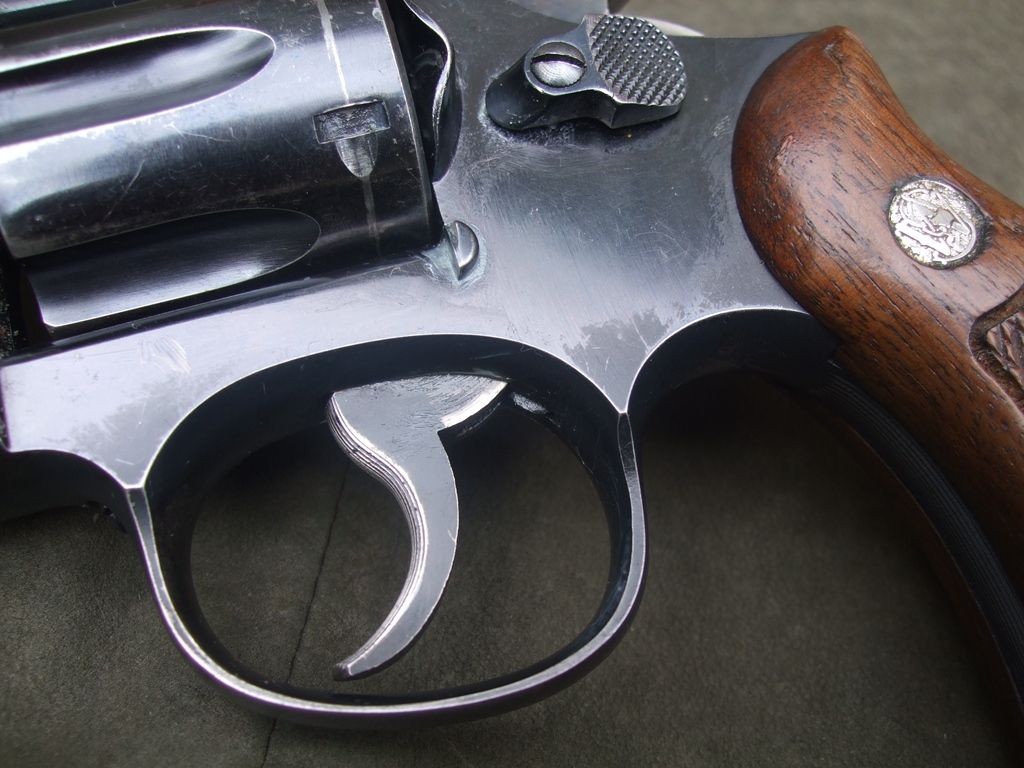
The sweet K-frame is best served by narrow trigger in conjunction with narrow hammer spur.

Smith & Wesson may have been the Queen Bee in introducing the floating firing pin on the K-22. Countersunk cylinder chambers provide clearance to prevent peening edge of chamber during dry fire.

Drop forged, case hardened hammer cocked for single action fire.
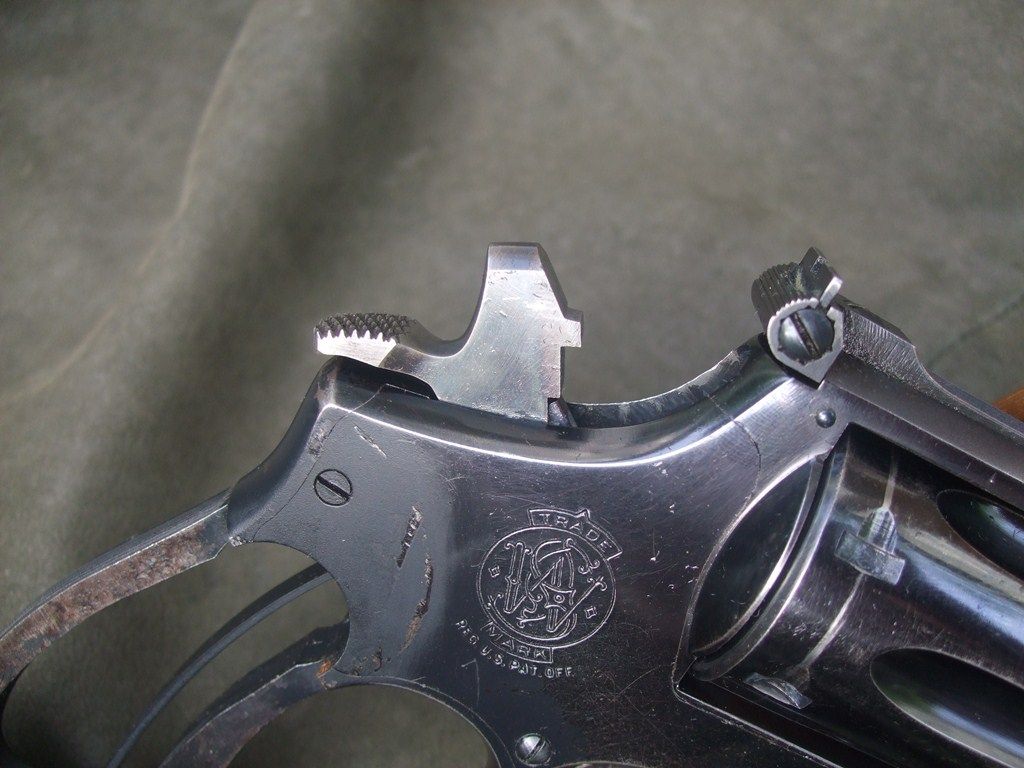
S&W recommends strain screw be adjusted for reliable double action ignition, with the shank filed to achieved desired pull. As opposed to loosening strain screw to achieved desired letoff. Over time, a screw which is not tight tends to loosen, which could cause a misfire. In practice, anyone with half a brain is sensitive to changes in tension and acts to prevent problems on the light side.
Mainspring is yet another drop forging. David having never encountered fatigue or breakage from the old time part, from .22 to .44 Magnum.
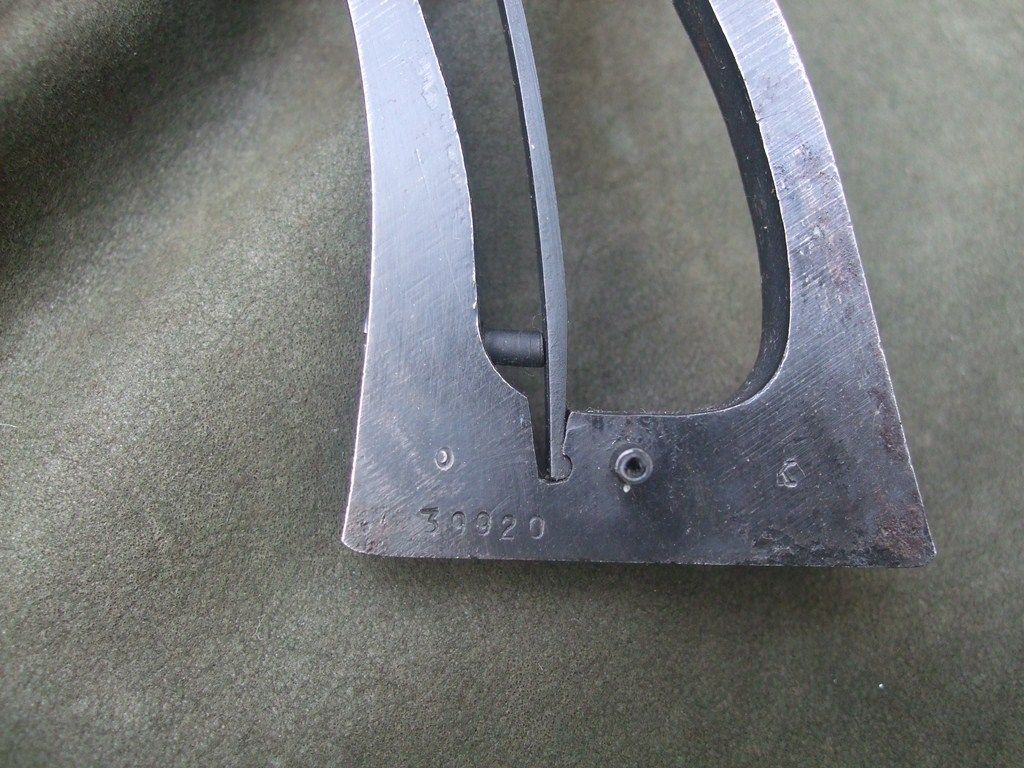
Screw in front of trigger guard secures spring and rod which activates cylinder stop (a.k.a. "bolt" to Colt; "cylinder latch" to Ruger). This arrangement prevents cramping or binding possible with the later spring, introduced late 1961 on M-17-2. This stop spring arrangement should have been kept, especially to prevent cylinder float on the M-29 .44 mag.

According to the jungle drums, S&W introduced model numbers in 1957. The words "K 22" fell symphonic upon David's youthful ears. Living with the revolver only sweetens the music. In the old days no one referred to the sixgun as anything but a "K-22." Likewise the popular "K-38" and, once in a while, the "K-32," all 6-inch target revolvers claimed by Smith & Wesson to weigh the same 38 ounces when loaded.
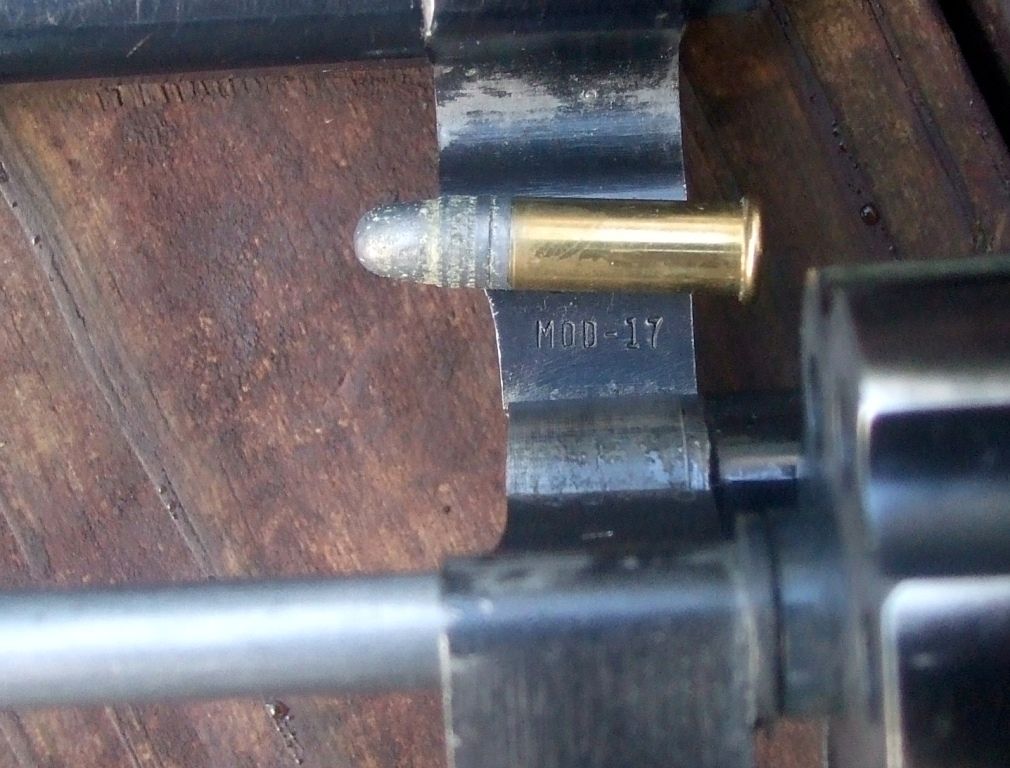
Old time target bullseye shooters burned beaucoup ammo, which probably convinced S&W to adopt the floating firing pin. A rimfire represents the height of balloon-head case design, a low pressure containment at best. A floating firing pin simplifies manufacture, while reducing headache on the user end. Although lubrication is not shown in picture, this revolver gets its share.
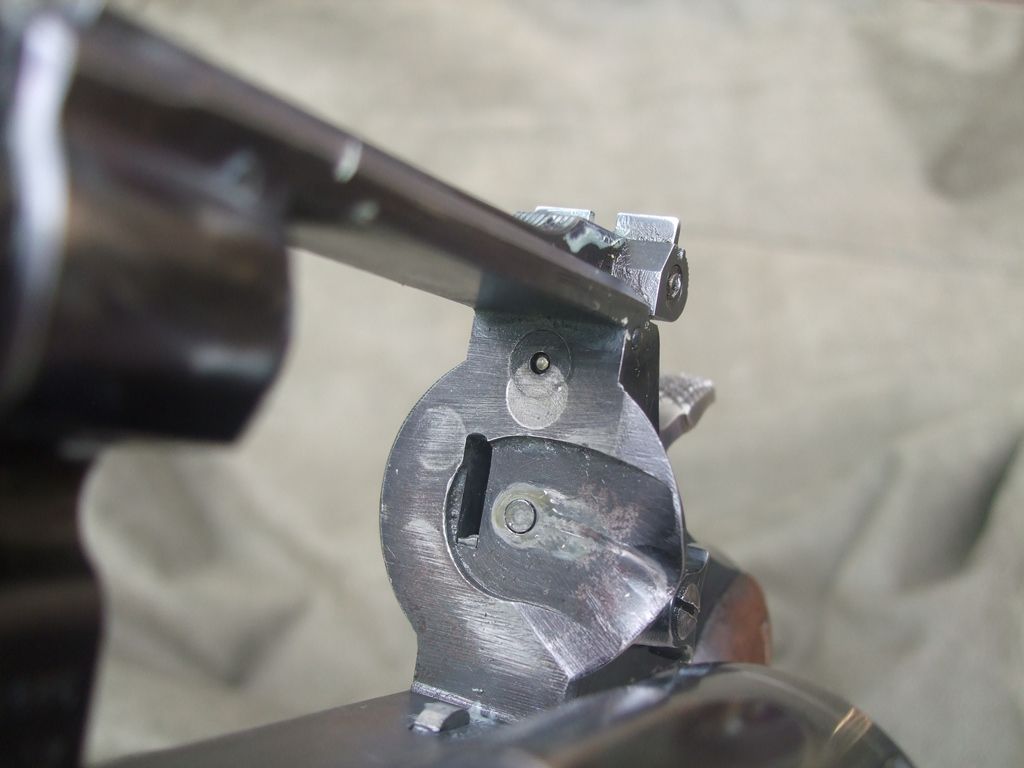
Fired brass as snap cap. Three dry fires before case extraction and rotation. Repeated strikes swell brass, limiting impacts to 2 or 3 for relative ease of extraction. In Part 2 we'll look at technique and accuracy.
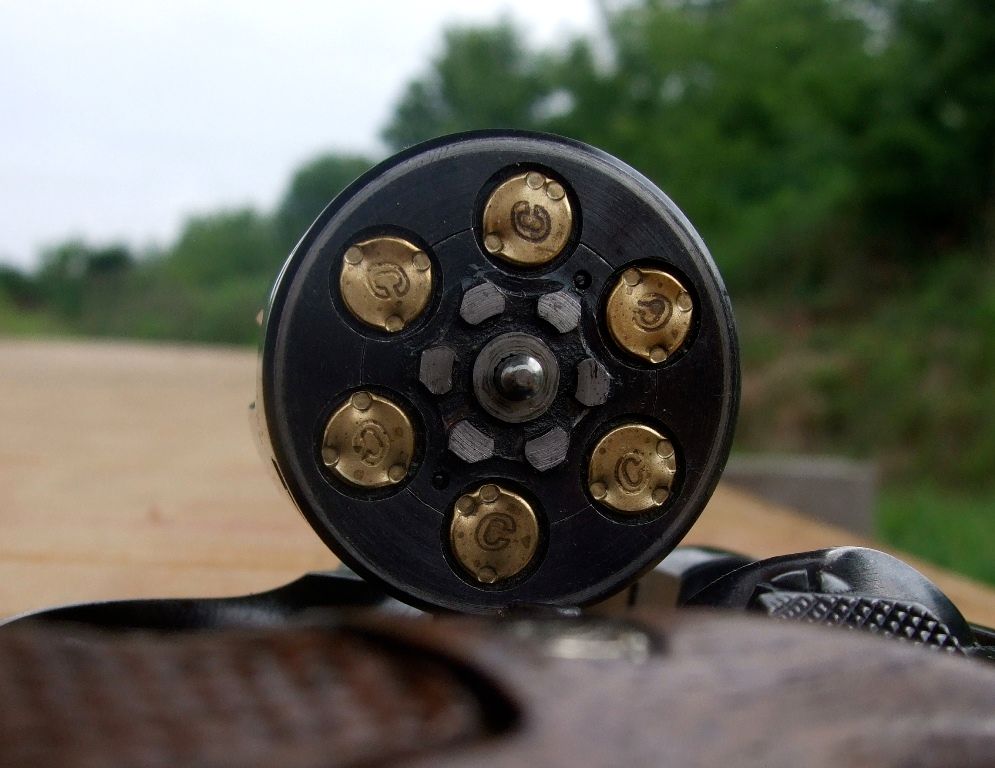
-Lee
www.singleactions.com
"Building carpal tunnel one round at a time"
Photo indicates two cylinders worth of .22 Long Rifles stroked in 2006, double action at 100 yards.

K-22 cartridge roll mark.on the old drop forged 6-inch barrel.

Vintage K-22. Flat black paint applied on occasion to protect against weather and preserve bluing. Paint shows around grip and trigger, etc.

Perhaps no revolver is more sensitive to dimensional irregularity than a .22 rimfire. The chamber has no step. Rather, the chamber narrows ever so slightly rear-to-front. Long Rifle ammo snugs into the exit hole. A soft lead bullet cannot abide caveman manufacturing, the K-22 representing the extreme opposite.

Close shave as lubed lead bullet enters chamber from the front.

Upon swingout, index and middle fingers of left hand hold cylinder at 9 o'clock to frame for clear ejection----and to prevent extractor star from scratching revolver! Normal ejection calls for muzzle to be raised to prevent brass and crap from collecting under star.

Most elegant Patridge sight to ever put on a handgun.

As the smoke of World War II drifted off, Smith & Wesson stepped once again into the sporting market, a most welcome development the fine rear sight with micro-clicks for elevation and windage. A detent ball in the flange of the respective screws makes for consistent adjustments. Among the many drop forged parts, the rear sight base. A habitual lubricator, with only Lubriplate white lithium grease at hand, David got carried away.

Note, immediately behind painted trigger, a little nubbin. This is the trigger stop, secured by a screw. Access requires removal of sideplate. Should the trigger stop screw loosen, adjustment nubbin may drop down, which then prevents trigger from releasing hammer. No such adversity has struck this K-22. S&W saw the potential and chose a rod inside the trigger rebound spring to limit overtravel in the .44 Magnum Model 29.

The sweet K-frame is best served by narrow trigger in conjunction with narrow hammer spur.

Smith & Wesson may have been the Queen Bee in introducing the floating firing pin on the K-22. Countersunk cylinder chambers provide clearance to prevent peening edge of chamber during dry fire.

Drop forged, case hardened hammer cocked for single action fire.

S&W recommends strain screw be adjusted for reliable double action ignition, with the shank filed to achieved desired pull. As opposed to loosening strain screw to achieved desired letoff. Over time, a screw which is not tight tends to loosen, which could cause a misfire. In practice, anyone with half a brain is sensitive to changes in tension and acts to prevent problems on the light side.
Mainspring is yet another drop forging. David having never encountered fatigue or breakage from the old time part, from .22 to .44 Magnum.

Screw in front of trigger guard secures spring and rod which activates cylinder stop (a.k.a. "bolt" to Colt; "cylinder latch" to Ruger). This arrangement prevents cramping or binding possible with the later spring, introduced late 1961 on M-17-2. This stop spring arrangement should have been kept, especially to prevent cylinder float on the M-29 .44 mag.

According to the jungle drums, S&W introduced model numbers in 1957. The words "K 22" fell symphonic upon David's youthful ears. Living with the revolver only sweetens the music. In the old days no one referred to the sixgun as anything but a "K-22." Likewise the popular "K-38" and, once in a while, the "K-32," all 6-inch target revolvers claimed by Smith & Wesson to weigh the same 38 ounces when loaded.

Old time target bullseye shooters burned beaucoup ammo, which probably convinced S&W to adopt the floating firing pin. A rimfire represents the height of balloon-head case design, a low pressure containment at best. A floating firing pin simplifies manufacture, while reducing headache on the user end. Although lubrication is not shown in picture, this revolver gets its share.

Fired brass as snap cap. Three dry fires before case extraction and rotation. Repeated strikes swell brass, limiting impacts to 2 or 3 for relative ease of extraction. In Part 2 we'll look at technique and accuracy.

-Lee
www.singleactions.com
"Building carpal tunnel one round at a time"



